
आवासीय प्रॉक्सीज़ ने 23 अप्रैल को 220,000 यूएस आईपी जोड़े।


AI वेब डेटा स्क्रैपिंग अनन्य प्रॉक्सी योजना [ असीमित ट्रैफ़िक, 100G+ बैंडविड्थ ]

 Language
Language

In today's digital age, artificial intelligence technology is advancing at an unprecedented pace, and the development of AI agents has become a focal point for many developers and enterprises.
Whether for automated tasks, smart decisions, or better user experience, a strong AI agent framework can give us great support.
So, how do you choose the most suitable one among so many frameworks? This article will give you a detailed analysis of the top AI agent building frameworks that you cannot miss in 2025.
The AI agent framework is like an "intelligent hub" that provides developers with a series of tools and components to make it easy and efficient to create, deploy and manage autonomous AI agents.
These frameworks not only cover the design of agent architecture, but also aspects such as memory management, task coordination, and integration with other tools, allowing AI agents to perceive the environment, process information, and take actions like humans.
Microsoft's AutoGen supports multi-agent collaboration, while LangChain simplifies the connection between large models and tool chains, enabling AI agents to complete complex tasks more efficiently.
Building an AI agent framework requires balancing technological innovation and commercial implementation, while paying attention to security, scalability, and standardization. Successful agent projects usually have a clear business model, a strong technical architecture, and real user demand support.
1. Clarify core business needs
The AI agent framework should be built around real business needs, not just as a technical demonstration. For example, agents in the financial field can optimize trading strategies, while customer service agents should improve user experience.
2. Technical architecture and framework selection
Zero code vs. development-friendly:
Frameworks such as AutoAgent allow non-technical personnel to create agents through natural language.
LangChain and AutoGen are more suitable for developers, providing modular components and API integration.
Memory management: Agents need long-term memory capabilities (such as vector databases) to optimize decisions.
Tool integration: Support external API calls (such as financial data, social media analysis) to enhance agent functions.
3. Scalability and performance optimization
Load balancing: Support high-concurrency tasks, such as recruitment agents needing to process thousands of resumes at the same time.
Multimodal support: The agent should be able to handle multiple data types such as text, voice, and video (e.g., A2A protocol).
Here are some of the best AI agent frameworks and their features for 2025:
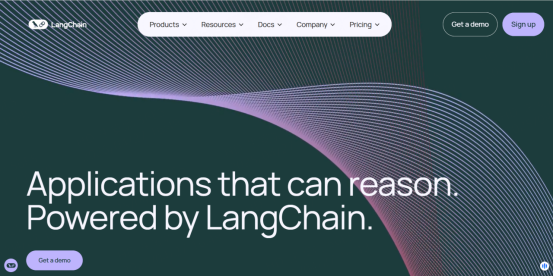
LangChain is a framework for developing applications powered by large language models (LLMs). It simplifies every stage of the LLM application lifecycle, including development, productionization, and deployment. With LangChain, developers can build applications using open source building blocks, components, and third-party integrations .
Repository link: LangChain GitHub
Programming language: Python
Development Team: Community
GitHub Stars: 106k+
Features:
Components such as language models and data sources can be easily replaced;
Connect language models to various data sources through intuitive high-level APIs;
Provide tools to optimize prompt words and obtain more accurate output;
Supports the development of RAG systems; memory modules can retain historical interaction information;
Highly customizable and flexible, capable of deploying and monitoring language model applications; comprehensive documentation with rich examples.
Supported models: OpenAI, Google, Hugging Face, Azure, AWS, Anthropic, etc.
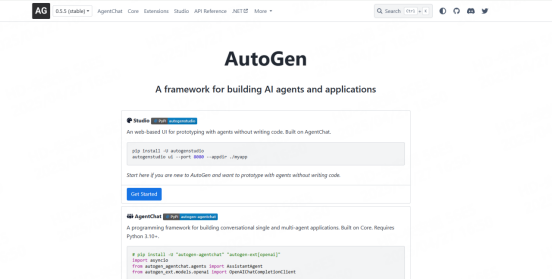
AutoGen is an open source multi-agent dialogue framework launched by Microsoft, which aims to help developers create intelligent applications based on large language models (LLM). It breaks down complex tasks into multiple subtasks and assigns them to different agents, completing the entire task through collaboration and communication between agents .
Repository link: AutoGen GitHub
Programming languages: Python , .NET
Development team: Microsoft
GitHub stars: 43.8k+
Features:
Cross-language support for Python and .NET;
Support for autonomous and attended agents;
GUI support is provided through AutoGen Studio;
Adopt a layered and scalable architecture;
Contains core API, AgentChat API and extension API;
Built-in proxy support for web browsing via Playwright;
Supports multimodal agents for browser automation and user interaction;
Supports polling group chats, and can end agent chats based on custom rules;
Contains the benchmarking tool AutoGen Bench; has a rich collection of tools, packages, and community-contributed agents.
Supported models: OpenAI, Azure OpenAI, Azure AI Foundry, Anthropic (experimental support), Ollama (experimental support), Gemini (experimental support), Semantic Kernel Adapter, etc.
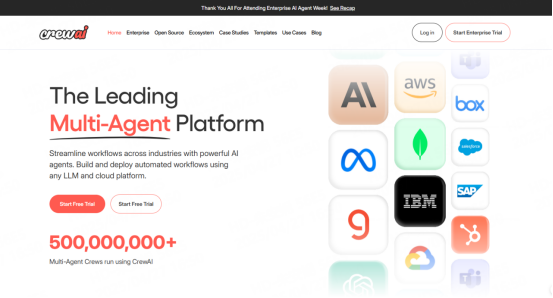
CrewAI is a cutting-edge autonomous AI agent collaborative orchestration framework, built specifically for designing and coordinating collaborative workflows of multiple AI agents. Through role-based division of labor, task orchestration, and process control, it enables multiple AI agents to work together like a professional team to complete complex tasks .
Repository link: CrewAI GitHub
Programming language: Python
Development team: CrewAI + Community
GitHub stars: 30.6k+
Features:
Can build independent AI agents, and can also orchestrate autonomous agents;
Combines autonomy and precision for real-world scenarios;
Customize every layer of the system, from high-level workflows to low-level prompts and agent behaviors;
Reliable performance for both simple and complex enterprise-level tasks; easily create powerful, flexible, and production-ready AI automations.
Supported models: OpenAI, Anthropic, Google, Azure OpenAI, AWS, Cohere, VoyageAI, Hugging Face, Ollama, Mistral AI, Replicate, Together AI, AI21, Cloudflare Workers AI, DeepInfra, Groq, SambaNova, NVIDIA, and more.
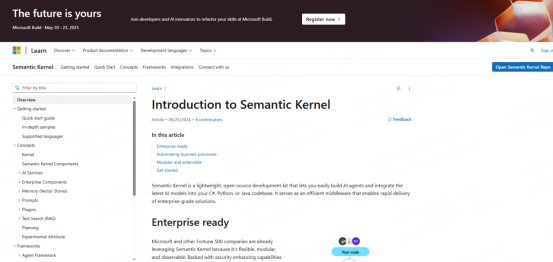
Microsoft Semantic Kernel is an open source SDK for building AI agents and multi-agent systems. It supports flexible orchestration, plug-in integration, and can be deployed locally or in the cloud in Python, .NET, and Java .
Repository link: Microsoft Semantic Kernel GitHub
Programming languages: Python, .NET, Java
Development team: Microsoft
GitHub stars: 24.2k+
Features:
Can connect to any LLM, with built-in support for OpenAI, Azure OpenAI, Hugging Face, NVIDIA, etc.
Support for building modular AI agents with access to tools, plugins, memory, and planning capabilities;
Supports orchestration of complex workflows in multi-agent systems;
Extensible, supporting native code functions, prompt templates, OpenAPI specifications or MCP integration;
Supports integration with vector databases such as Azure AI Search, Elasticsearch, Chroma, etc.
Support multimodal capabilities for processing text, visual, and audio input;
Can be deployed locally, such as using Ollama, LMStudio or ONNX.
Supported models: Amazon AI, Azure AI, Azure OpenAI, Google models, Hugging Face, Mistral AI, Ollama, Onnx, OpenAI, Hugging Face, NVIDIA, etc.
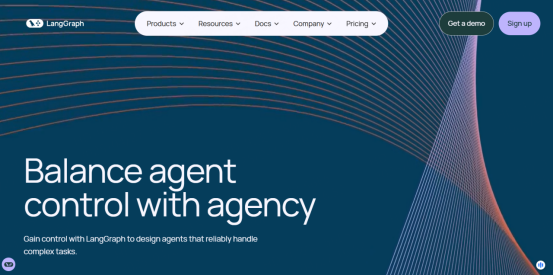
LangGraph is a framework in the LangChain ecosystem that builds powerful and stateful multi-participant applications by modeling steps as edges and nodes in a graph. It integrates seamlessly with LangChain, but can also be used standalone.
Repository link: LangGraph GitHub
Programming language: TypeScript
Development Team: Community
GitHub stars: 12k+
Feature
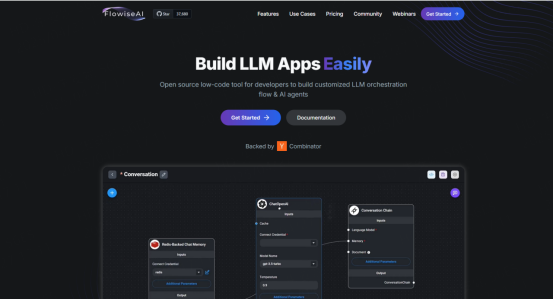
Flowiseis an open source low-code tool designed to help developers easily build custom large language model (LLM) processes and AI agents. Through an intuitive drag-and-drop interface, it allows users to quickly create and deploy LLM applications without writing complex code .
Repository link: Flowise GitHub
Programming language: TypeScript and JavaScript.
Development Team: Developed by the FlowiseAI team, backed by Y Combinator.
GitHub stars: 37.7k+
Features:
Build LLM applications by dragging nodes, such as question-answering systems, text analysis, etc., and support LangChain and LlamaIndex ecological components ;
No programming experience is required, AI applications can be created by dragging and dropping ;
Supports running in local or private cloud environments to ensure data security ;
Completely open source, allowing users to customize and extend freely ;
Supports Docker/Kubernetes deployment, environment isolation, and the enterprise version supports team collaboration.
Supported models: OpenAI GPT series, HuggingFace model, Anthropic Claude, Llama2, Mistral, Vicuna, Orca, Llava, etc.
After learning about these top AI agent frameworks in detail and comparing them, we get a clearer idea of what each one is good at and where it works best. When picking a framework, we can decide wisely based on what our project needs, our technical skills, and what we hope it can do.
If you want to develop a proxy, you can't do it just by relying on the framework without collecting data. Fortunately, LunaProxyprovides you with the help of data collection. Unlimited proxies allow you to get data supply in an uninterrupted flow.
I hope this information can provide valuable reference and assistance for your AI agent development journey. You can create a LunaProxy account to start your AI agent journey.
